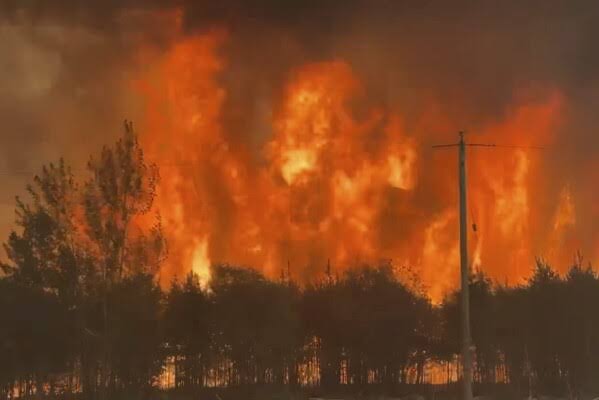Canadian Wildfire Smoke Pushes South, Worsens Air Quality Across U.S. Midwest
Smoke from dozens of wildfires in Canada’s Manitoba province is drifting south into the United States, significantly lowering air quality across parts of the Midwest and posing health risks for sensitive groups.
High-altitude winds are pushing smoke from northern Canada into states like Minnesota, Wisconsin, Iowa, and Illinois, with air quality levels ranging from “moderate” to “unhealthy”, according to the Environmental Protection Agency’s AirNow monitoring system.
By Friday afternoon, air quality maps showed a broad swath of orange AQI alerts—indicating unhealthy air for sensitive groups—stretching from Minnesota down into Wisconsin. Surrounding areas, including Michigan’s Upper Peninsula, eastern Iowa, and northwest Illinois, registered moderate levels (yellow), signaling that air is acceptable for most people but could affect those with existing health conditions.
Patrick Ayd, a meteorologist with the National Weather Service in Duluth, Minnesota, said smoke particulates may continue drifting further south into Oklahoma, Tennessee, and Arkansas by Saturday.
“It’s getting a little hard to breathe,” said Murray Kinsey, a houseboat business owner near Babbitt, Minnesota. “It’s hazy out there, but we’ve seen worse.”
The Air Quality Index (AQI) is a daily measure of how clean or polluted the air is. It focuses on pollutants like ground-level ozone and particulate matter, which can trigger breathing problems and worsen chronic health conditions. Orange levels signal caution for young children, the elderly, and people with asthma or heart disease, while red levels—expected in parts of northern Minnesota—mean the air is unsafe for everyone.
The Minnesota Pollution Control Agency warned residents to limit outdoor activities and remain indoors with doors and windows shut. It also recommended avoiding wood-burning appliances, candles, and incense, which can worsen indoor air quality.
Meanwhile, North Dakota’s environmental agency said it is closely monitoring air conditions and urged people to reduce prolonged outdoor exertion.
The wildfire situation in Canada remains severe. Manitoba has declared a state of emergency, with more than 100 wildfires already recorded this year and nearly 17,000 people evacuated from communities across the province.
Forecasters expect some of the smoke may interact with scattered thunderstorms in the Chicago area Friday evening. However, the smoke plume is following a cold front, and meteorologists say it may begin to thin over the next couple of days.
“We are getting the smoke,” said Kevin Doom, a National Weather Service meteorologist in Chicago. “High-altitude winds—10,000 to 20,000 feet up—are blowing it down from the north. Minnesota’s taking the brunt for now.”
Doom said the smoke is expected to gradually disperse but will continue drifting across the region in the short term.
Canada’s wildfire season typically runs from May through September, and experts warn that 2025 could rival the record-setting 2023 season, which blanketed large portions of North America in hazardous smoke for months.



[…] Minister and Deputy Prime Minister Ishaq Dar made the announcement on Friday, stating that Pakistan would upgrade its diplomatic representation from a charge […]
[…] has directed the early payment of June salaries to all civil servants across the state, beginning Monday, to enable them to prepare for the forthcoming Eid-el-Kabir […]